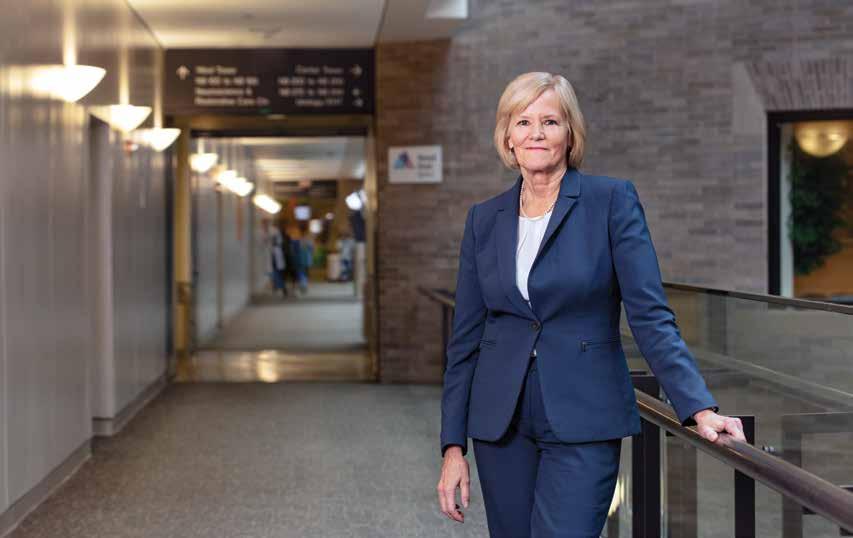
8 minute read
The Chief Nursing Officer: A Critical System-Level Role for Nursing
The Chief Nursing Officer: A critical system-level role for nursing
By Andrea Kott, MPH
Advertisement
Photographs by Jörg Meyer
The nursing career that Kevin Browne ’92, DNP, RN, envisioned more than 30 years ago focused on alleviating suffering, one patient at a time. Back then, Browne specialized in critical care, working with post-surgery cardiothoracic patients. “I believed I had a great capacity to give,” he says.
Over the years, Browne found that he also had a bent for leadership, which earned him charge nurse and committee head appointments at the hospitals where he worked. “I realized I had the capacity to lead a nursing service,” says Browne, now deputy chief nursing officer (CNO) at Memorial Sloan Kettering Cancer Center in Manhattan. More importantly, he realized that being a nurse leader exponentially increased his ability to serve patients by positioning him to help shape the delivery of care systemwide. “When I became a head nurse, I realized that I could influence many of the nurses who were delivering care, as opposed to influencing just one patient. As a director, I could influence hundreds of nurses. And now, as deputy chief nursing officer, I can influence thousands.”
The opportunity for nurses to influence patient care by helping to shape and navigate health-care systems is a relatively recent phenomenon—an answer to a 2011 report by the Institute of Medicine. That report, titled The Future of Nursing: Leading Change, Advancing Health, called for strong leadership to transform health care by increasing quality, accessibility, effectiveness, and cost efficiency. It spoke forthrightly to the nursing profession as a major force in the patient experience and paved the way for CNOs like Browne and others—including Kerri Scanlon ’93 ’97, MSN, RN; Mary Ann Donohue-Ryan ’98, PhD, RN; and Frances Cartwright ’92 ’93, PhD—to advance its mandate. This is, they all agree, vital to improving the care that every patient receives. “CNOs are critical to the movement of health-care organizations,” Browne says. “You cannot deliver quality patient care with high performing outcomes and metrics without them.”
A profession of doers and leaders
Nursing has always been a profession of doers and leaders. In addition to serving as the primary providers of hands-on care, nurses have long held leadership roles in education and policy, while their important work as patient advocates has made NPs leaders in practice.
But changes in the health-care landscape—including shrinking reimbursements, the shift from volume-based to value-based care, and the aging and increasing clinical complexity of the American population—have created a need for a special type of nurse-leader: one whose clinical, administrative, and budgetary expertise could advance a health-care organization’s strategic vision.
“It became a mandate that there needed to be one nurse at the helm of nursing services, someone who would be required to maintain clinical and patient-care standards; to ensure that patients were receiving safe, accurate, highquality care; and to see that dollars were there to support the resources needed to meet the changing volume and acuity of patient populations,” Browne says.

Kevin Browne, DNP, RN
This “one nurse,” the CNO, has a 360-degree understanding of how a hospital or other health-care organization works and is therefore a critical member of the executive leadership team, says Scanlon, CNO for North Shore University Hospital in Manhasset, N.Y., and deputy CNO for Northwell Health. “The CNO is the person who completely understands not only the care being provided but also the entire milieu and perspective of an organization and how it provides care,” Scanlon says.
Scanlon began her career as a medical-surgical nurse and went on to specialize in critical care, working in cardiothoracic intensive care and as a critical-care educator. “I never said, ‘I want to be the CNO of a hospital,’” she recalls. She accepted the assistant directorship of a systems quality department, then became assistant vice president for corporate quality, and, finally, was named CNO. “I’ve been in charge of medical records, case management, social work, and pharmacy,” she says. In her current position, Scanlon works closely with Northwell Health’s nurse executive team to establish the strategic vision for nursing and patient care services across the 23-hospital health system. “It’s the most phenomenal job I’ve ever had,” she says.
Before the women’s movement, a male health-care executive would likely have held Scanlon’s job, but since then, leadership opportunities for women have flourished, Donohue-Ryan says. “The ability of nurses to influence care at the bedside is a direct result of the opportunities that have been afforded to women in the workplace, especially leadership development, over the past 30 years.” Because of these expanded opportunities, nurses like Donohue-Ryan have been able to practice clinically, while also holding leadership positions. “My personal goal wasn’t to choose between leadership and clinical care,” says Donohue-Ryan, who was CNO at several hospitals in New Jersey (Englewood Hospital and Jersey Shore University Medical Center) and New York (Stony Brook University Hospital), and is now a consultant at the Chilton Medical Center in Pompton Plains, N.J. and at White Plains Hospital in Westchester, N.Y. “The position that launched my administrative career was a director of nursing position for behavioral health, while I also functioned as an advanced practice nurse,” Donohue-Ryan says.
She notes that the women’s movement is just one of the factors—along with the changing health-care economy, the inception of the American Nurses Association’s Magnet Recognition Program, and influential organizations like the American Association of Nurse Leaders—that spawned and nurtured the emergence of the CNO as a full-fledged executive leader, equivalent to other senior hospital administrators in function and authority. “In a Magnet organization, nursing leaders must be peers to every other senior executive around the boardroom table, with the same 24/7 accountability, and access to the president and CEO.”

Kerri Scanlon, MSN, RN
Ensuring such accountability is essential in today’s health-care marketplace, where outcomes drive reimbursement rates, according to Cartwright. “Nursing is in a pivotal position to lead the redesign of healthcare delivery so that we keep our patients safe, while delivering patient-centric, excellent-quality care,” she says. “We need CNOs to be at the table to advance health-care policy and influence changes that include the voices of the patient, family, and community, while considering social determinants of health. Continued investment in the practice of nursing so that all nurses practice at the top of their license in a culture of safety is key to making this paradigm shift.”
Cartwright, the CNO at Mount Sinai Hospital in Manhattan, began her career as an oncology nurse. “It wasn’t on my bucket list to be a CNO,” she says. As she progressively assumed more and more significant leadership roles, she found that being an executive leader allowed her to influence organizational excellence. “My major aim is always to support and invest in frontline nurses,” she says. “It is the frontline nurse who partners with the patient and family to make that personal connection so that individuals’ needs, concerns, and desires are considered. They help us keep patients safe and provide them with quality care.”
Supporting frontline RNs
Among the CNO’s key functions is championing the critical role of frontline RNs by giving voice to their needs, from increased staffing to continuing education. Importantly, the CNO’s role also includes conveying RNs’ perspectives about their patients’ needs for equipment and other resources, Donohue-Ryan adds. “The CNO connects the dots between decisions that are often based on financial reasons and how those decisions translate into the best-quality patient-care outcomes.”

Mary Ann Donohue-Ryan, PhD, RN
Connecting the dots—that is, conveying how quality is always connected to financial decisions—is not always easy among colleagues who are equally concerned about maintaining the bottom line but may need help navigating the language of professional and regulatory standards, Donohue-Ryan notes. This could be the case, for example, if meeting patients’ needs requires a certain level of staffing that exceeds an institution’s budget, she explains, or if staffing levels seem excessive in outpatient areas where nurses appear to a nonclinical manager, director, or executive to be monitoring patients, rather than constantly performing critical assessments as they care for a problem-prone, high-risk, vulnerable population. “Nurses perform rapid evidence-based assessments every time they are involved in patient care, so there is no such thing as an educated, licensed nurse whose function is restricted to reporting only preset parameters,” Donohue-Ryan says. Even requests for supplementary nursing education may strike some as superfluous. “I remember one colleague early in my career who asked why staff nurses would ever need simulation education for hands-on learning,” Donohue-Ryan recalls. “He asked, ‘Why can’t they sit in front of a computer and point and click? Didn’t they get what they needed in nursing school?’”
In addition to championing nurses’ clinical practice needs, CNOs support their participation in legislative affairs and institutional policy- and decision-making, all of which are essential in helping nurses understand and embrace the rationale behind their work, Donohue-Ryan adds. “Shared decision-making actually is proven to help guide administrative decisions to prepare better informed executives.”
Having decision-making input deepens nurses’ engagement with their work, Cartwright says. “We need the critical thinking skills, passion, and experience of the frontline nurses to innovate changes in process and structures to improve care and, in turn, the overall patient experience,” she says. Policies and procedures that promote nurse autonomy and clinical ladders to provide career advancement at the bedside are two examples of how nurse leaders invest in and support nurses.

Frances Cartwright, PhD
Such support promotes increased nursing engagement and reduces job dissatisfaction and attrition, sparing hospitals and other health-care institutions the financial burden of constant recruitment. Plus, Cartwright adds, it attracts new nurses. “Engaged nurses are talent magnets,” she points out.
A pivotal role in positive change
In the years since she became a CNO, Scanlon says she has seen many productive changes in health care, most notably the demand for big data. “In 1999, medical error contributed to the deaths of 90,000 hospital patients in the United States,” she says. To reduce spending on potential medical errors, payers began basing reimbursements on outcomes data, which heightened the requirement for provider accountability. Leveraging such data to justify reimbursement rates and drive quality improvement initiatives is among Scanlon’s many responsibilities as CNO. Indeed, big data allowed her to design and lead initiatives at North Shore University Hospital that, among other things, decreased the incidence of pressure ulcers by 90 percent and produced a 45 percent improvement in the rate of patient falls. “CNOs know what needs to occur not only in terms of business and finance but also, and most importantly, in developing models of care that are going to drive desired outcomes,” she says. “To me, that’s the greatest indicator of exceptional nursing.”
Despite CNOs’ increasingly pivotal role in transforming health care, many agree that there remains some resistance toward having a CNO—or any nurse—at the executive table. “We’re still evolving toward universal recognition of nurses as leaders,” Scanlon says. “I’ve been quite fortunate in my career in that our organization has valued nursing leadership presence at the table.”
What’s more, even organizations that promote nursing leadership do not always have the tools they need to develop it. “Nurses in leadership positions ought to be educated at the top of their license, yet we have a shortage of qualified PhD faculty in nursing schools across the country to do the teaching,” Donohue-Ryan says.
The good news is that the growing opportunities awaiting CNOs, and the strides they are making in improving patient care, outweigh the hurdles they face. “We’re leaders because of who we are, not just what we do,” Browne says. “We’re not just deliverers of care who alleviate suffering. We are executives who have a sphere of influence that was unrecognized years ago but is more recognized every day.”


